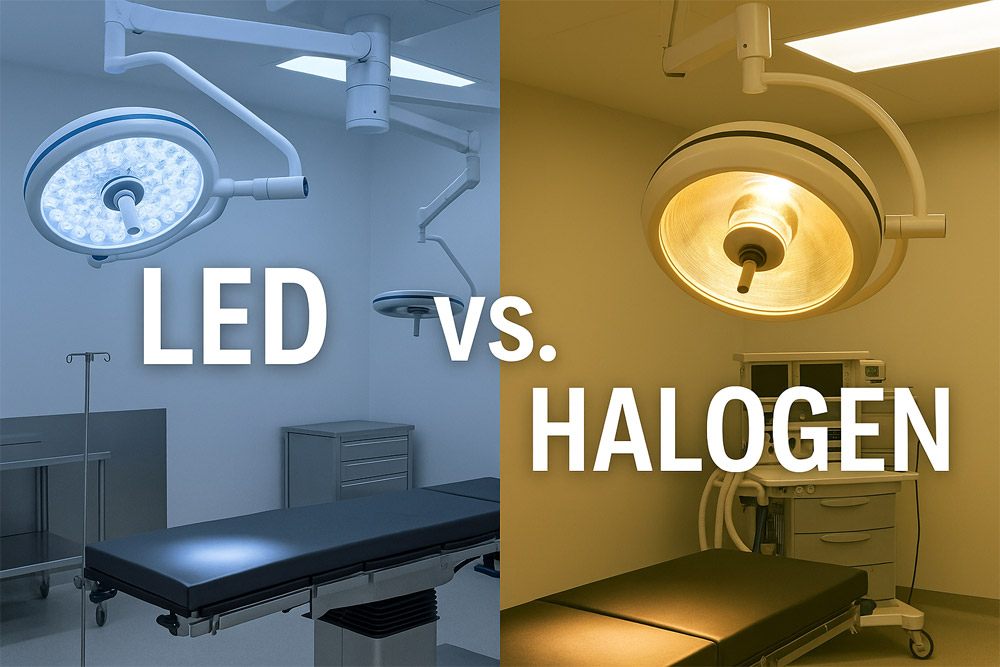

Surgical lights play a critical role in operating rooms, ensuring surgeons have optimal visibility during procedures. Two of the most commonly used technologies are halogen and LED (light-emitting diode) lights. While both aim to provide bright, shadow-free illumination, they differ significantly in performance, efficiency, and cost.
In this article, we'll break down the key differences between LED and halogen surgical lights to help you make an informed decision.
What Are Halogen Surgical Lights?
Halogen surgical lights are traditional operating room lights that use halogen gas-filled bulbs to produce a bright, focused beam. They have been widely used for decades due to their affordability and consistent performance. However, they emit more heat and consume more energy compared to modern alternatives.
What Are LED Surgical Lights?
LED (Light Emitting Diode) surgical lights are a newer generation of operating room lighting. They use semiconductor technology to produce a bright, white, and energy-efficient light source. LEDs have become increasingly popular for their long lifespan, low heat output, and improved color rendering capabilities.

Key Differences Between LED and Halogen Surgical Lights
1. Light Quality and Brightness
LED lights produce a whiter and brighter light compared to halogen bulbs. This high-intensity illumination improves color rendering, which is crucial in differentiating tissues, arteries, and veins during surgery. The Color Rendering Index (CRI) of LED lights typically exceeds 90, offering more natural color perception.
Halogen lights emit a yellowish light that can sometimes distort color visibility. Their CRI is usually lower than LED, making them less ideal for procedures requiring high visual accuracy.
2. Heat Generation
One of the major drawbacks of halogen surgical lights is the excessive heat they produce. This can cause discomfort for both patients and surgeons, and may increase the risk of tissue dehydration during prolonged operations.
LED lights, by contrast, produce minimal heat. They remain cool to the touch and reduce thermal radiation, creating a more comfortable and safer surgical environment.
3. Energy Efficiency
LED technology is significantly more energy-efficient than halogen. LEDs consume up to 70% less power, which can lead to substantial savings in electricity costs, especially in high-usage ORs.
Halogen lights require more power to achieve the same brightness levels, which can result in higher operating costs over time.
4. Lifespan and Maintenance
LED surgical lights have a much longer lifespan, often exceeding 40,000 to 50,000 hours of use. This greatly reduces the need for frequent replacements and maintenance.
In comparison, halogen bulbs typically last only 1,000 to 2,000 hours, requiring more frequent changes and potentially causing interruptions in OR schedules.
5. Cost Considerations
While LED surgical lights have a higher upfront cost, they offer better value over time due to lower maintenance and energy expenses. For hospitals looking for long-term investment, LEDs are more cost-effective.
Halogen lights are cheaper initially, making them suitable for facilities with tight budgets, but higher long-term costs should be considered.
6. Environmental Impact
LEDs are more environmentally friendly, containing no hazardous substances like mercury. They also reduce waste due to their long lifespan. Halogen lights are less sustainable, requiring more frequent disposal and consuming more energy.
Summary: Which One Is Right for You?
| Feature | LED Surgical Lights | Halogen Surgical Lights |
| Brightness/CRI | High, natural color visibility | Lower CRI, yellowish light |
| Heat Output | Very low | High |
| Energy Efficiency | Very efficient | Less efficient |
| Lifespan | 40,000–50,000 hours | 1,000–2,000 hours |
| Maintenance Cost | Low | High |
| Initial Cost | Higher | Lower |
| Eco-Friendliness | Excellent | Poor |
If you're upgrading your operating room, LED surgical lights are the clear choice for long-term performance, safety, and efficiency.
References
1. Association of periOperative Registered Nurses (AORN) – https://www.aorn.org
2. World Health Organization (WHO) – https://www.who.int/publications/i/item/surgical-care-systems-strengthening
3. Getinge Group – https://www.getinge.com
4. STERIS Healthcare – https://www.steris.com/healthcare
5. Journal of Clinical Engineering – https://journals.lww.com/clinicalengineering
6. Hillrom (Now part of Baxter) – https://www.hillrom.com